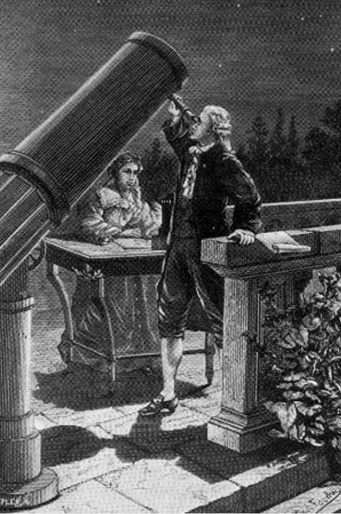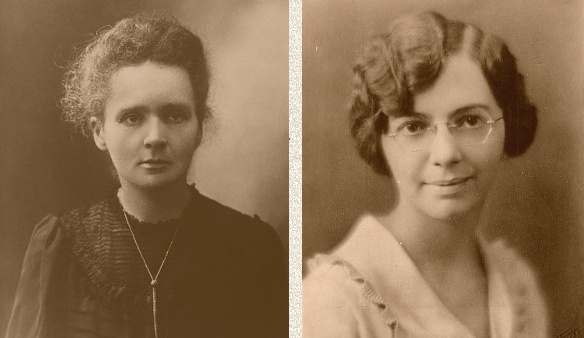Sexism in Science
September 28, 2012
There are few women in most fields of
science, and in
engineering and
mathematics. The reason for this might be that women are smarter than men, so they make better career choices. Of course, there are many advantages in working in
STEM fields, so much so that we forget its biggest disadvantage. You're never a scientist just from
9-to-5. You're a scientist every waking moment of the day; and, as often happens, in the sleeping moments, when you're
dreaming,
Richard Feynman was a prime example of this. While having lunch at the
Cornell University cafeteria, Feynman observed someone throwing a
plate into the air. That was before ubiquitous
Styrofoam, so the plate was a
china plate with the
Cornell University emblem. Feynman noticed that the
rotation rate of the emblem (and, therefore, the plate) was half the wobble rate, and he derived
equations as to why that was true.[1] I wonder if he remembered to eat his lunch.
There are enough women scientists, engineers and mathematicians that they have their own organizations. Here are the largest:
• Association for Women in Science (AWIS)
• Association for Women in Mathematics (AWM)
• Society of Women Engineers (SWE)
• Sigma Delta Epsilon/Graduate Women in Science (GWIS)
• Association for Women Geoscientists (AWG)
• National Center for Women & Information Technology (NCWIT)
I've written articles about a few women scientists, as follows:
• Lynn Margulis (Lynn Margulis, November 28, 2011
• Maria Goeppert-Mayer (Maria Goeppert Mayer, Sept. 9, 2011
• Mildred Dresselhaus (Ms. Carbon,March 12, 2007)
Dresselhaus said that her own role model was another woman scientist,
Rosalyn Yalow, who taught
physics at
Hunter College while Dresselhaus was a student there. Before being mentored by Yalow, Dresselhaus never thought she could become a
physicist. Yalow was awarded the 1977
Nobel Prize in Physiology or Medicine for the development of
radioimmunoassay.
A woman computer scientist is a principal character of my novel,
Mother Wode, and she isn't there just as
eye candy. She holds her own with the men in her life, but such a relationship between women scientists and their male counterparts is a very recent phenomenon.

(Image: Caroline Herschel taking notes on March 13, 1781, as her brother, William discovers Uranus. Source: Wikimedia Commons)
Several centuries ago, the only women practicing science were the
wives, daughters and sisters who acted as assistants to their scientist kin. When the male scientist died, many of their female kin continued their work, sometimes publishing still in the man's name, or finding an established scientist who would promote publication in the woman's own name.
Caroline Herschel, the sister of the astronomer, William Herschel, was such an important part of her brother's observations that she received a small salary from King George III, and she was awarded a gold medal from the Royal Astronomical Society.
Moving forward, we have the archetypal woman scientist,
Marie Sklodowska-Curie, who shared the 1903
Nobel Prize in Physics with her husband,
Pierre, for their work with
radioactive elements. Pierre died in 1907, and Marie went on to receive the 1911
Nobel Prize in Chemistry for her isolation of
radium.

Marie Sklodowska-Curie (1867-1934), circa 1898 (left), and biochemist, Florence Barbara Seibert (1897-1991) (right). Siebert developed the standard skin reaction test for tuberculosis while teaching at the University of Pennsylvania. Source images, from Wikimedia Commons, left; right)
The question arises as to whether the dearth of women in STEM fields is a consequence of their personal inclination or
societal forces. A recently published paper in the
Proceedings of the National Academy of Sciences (PNAS) provides evidence that there is a
bias against women in science.[2-3] Lest we place all the blame on the men, it turns out that female scientists are also biased against women. It's interesting to note that the female authors of this paper outnumber their male coauthors three to two.
This study, conducted by researchers from various departments at
Yale University, asked 127
biology,
chemistry and
physics professors to evaluate student applications for a hypothetical
laboratory manager position. They were asked to to give useful feedback to the students on such issues as potential
salary, competence and
hireability, but the real purpose was to collect data for the study. Identical applications were crafted, except that half of the professors were given an application with a male name, and the other half were given one with a female name.[2]
Not surprisingly, the male students were scored better. Quoting from the abstract of the PNAS paper,
"Faculty participants rated the male applicant as significantly more competent and hireable than the (identical) female applicant. These participants also selected a higher starting salary and offered more career mentoring to the male applicant."[3]
Surprisingly, female professors were just as harsh on the female students.
"The gender of the faculty participants did not affect responses, such that female and male faculty were equally likely to exhibit bias against the female student."[3]
The difference in ranking was quite pronounced. On a scale of 0-5, the male student scored 4.01 to the female student's 3.33. The female professors were harsher to the women as far a salary was concerned, recommending $25,000 against the male applicant's $29,333. The male professors opted for a ($30,520 male/$27,111 female) split.[2]
In their conclusions, the study authors write,
"It is noteworthy that female faculty members were just as likely as their male colleagues to favor the male student. The fact that faculty members' bias was independent of their gender, scientific discipline, age and tenure status suggests that it is likely unintentional, generated from widespread cultural stereotypes rather than a conscious effort to harm women."[3]
References:
- Richard P. Feynman and Ralph Leighton, "Surely You're Joking, Mr. Feynman!," W. W. Norton & Company, New York, 1985 (via Amazon); see also, this quotation from the book.
- Scott Jaschik, "Smoking Gun on Sexism?," Inside Higher Education, September 21, 2012
- Corinne A. Moss-Racusin, John F. Dovidio, Victoria L. Brescoll, Mark J. Graham and Jo Handelsman, "Science faculty's subtle gender biases favor male students," Proceedings of the National Academy of Sciences, September 17, 2012; a PDF copy of the paper can be accessed here.
Permanent Link to this article
Linked Keywords: Science; engineering; mathematics; STEM fields; 9-to-5; dream; Richard Feynman; Cornell University; cafeteria; dish; plate; Styrofoam; bone china; Cornell University emblem; rotation rate; equation; Association for Women in Science (AWIS); Association for Women in Mathematics (AWM); Society of Women Engineers (SWE); Sigma Delta Epsilon/Graduate Women in Science (GWIS); Association for Women Geoscientists (AWG); National Center for Women & Information Technology (NCWIT); Lynn Margulis; Maria Goeppert-Mayer; Mildred Dresselhaus; Rosalyn Yalow; physics; Hunter College; physicist; Nobel Prize in Physiology or Medicine; radioimmunoassay; eye candy; wife; wives; daughter; sister; Caroline Herschel; astronomer; William Herschel; King George III; Gold Medal of the Royal Astronomical Society; Royal Astronomical Society; Uranus; Wikimedia Commons; archetype; archetypal; Marie Sklodowska-Curie; Nobel Prize in Physics; Pierre Curie; radioactive element; Nobel Prize in Chemistry; radium; biochemist; Florence Barbara Seibert (1897-1991); tine test; skin reaction test; tuberculosis; University of Pennsylvania; norm; societal forces; Proceedings of the National Academy of Sciences; sexism; gender bias; Yale University; biology; chemistry; physics; professor; laboratory; manager; salary; Surely You're Joking, Mr. Feynman!